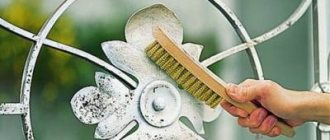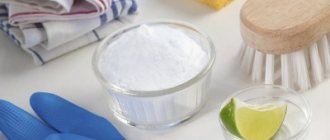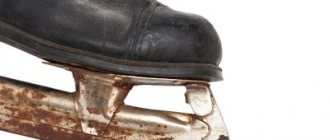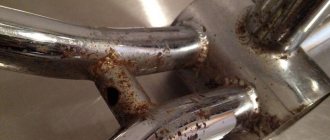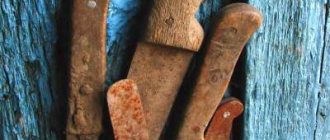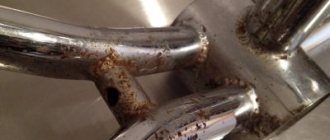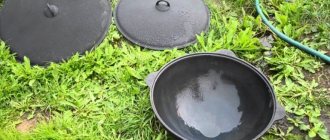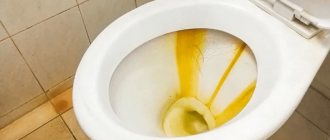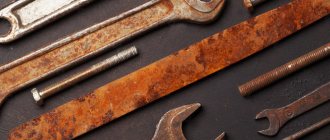A bicycle, like any vehicle, needs care. If you don't treat him well enough, he may present some unpleasant surprise at the most necessary moment. However, surprises can await you even when you are just starting to prepare for the cycling season. For example, you decided to see the condition of your two-wheeled friend, brought it from the balcony into the room and discovered that the steering wheel and the iron parts of the pedals were covered with a reddish coating. How to remove rust from a bicycle? This is what this article will discuss.
What is rust and why does it occur?
Rust is a reddish coating on iron surfaces. It is a mixture of iron oxides and hydroxides, that is, products of corrosion (deterioration) of iron. Rust occurs from contact of iron with air and water. Accordingly, bicycle parts may rust if:
- the bicycle was stored for a long time in a damp room;
- you didn’t wipe your bike well after washing;
- the bike was exposed to heavy rain, and you forgot to put it in order;
- the chrome or nickel coating of the steering wheel is damaged - chrome and nickel prevent corrosion of iron, but if the coating is damaged, the iron oxidizes underneath it.
What parts of a bicycle rust? How to remove rust from a bicycle?
By examining your bike, you can make sure that it is not completely rusted, even if it lay on the balcony all winter without any shelter. For example, the frame most likely was not damaged.
Why? — Because it is painted, and most likely a special anti-corrosion agent has been added to the paint. Most often they rust:
- iron parts of pedals;
- steering wheel;
- unpainted steering column;
- chain;
- iron wheel parts;
- knitting needles
Important! The frame can also rust if the coating is damaged.
Prevention measures
Knowing why rust forms and which parts rust faster than others can help you avoid corrosion. Prevention measures are quite simple:
- After riding in the rain and mud, thoroughly wash and dry all parts of the bicycle.
- In winter, store your bike in a dry room, and if it is on your balcony, then in a case or under a tarpaulin.
- Regularly lubricate moving parts with machine oil.
- The frame needs to be painted regularly.
- Ensure the integrity of the chrome or nickel coating.
If rust appears on your bike
How can you remove rust from metal?
What to do when, despite all your worries, a nasty red plaque still appears? Rust and a bicycle are two incompatible things. How to remove rust from a bicycle? First, assess the problem:
- The bike has one or two small rust spots.
- There are many rust spots, but they are small.
- Everything that is not painted is affected by rust.
Depending on the clarified situation, the methods for removing rust from a bicycle will vary.
What are the ways to remove rust from metal at home?
How to remove rust from a bicycle at home
There are several ways to remove rust stains from a bicycle:
- chemical;
- mechanical;
- mixed - using home remedies.
Preparation of materials and tools
In this case, you will be helped out by:
- metal brush or scraper;
- paper towels;
- mineral oil;
- acid;
- diesel fuel;
- grease;
- napkins;
- cotton swabs.
Features of cleaning in hard-to-reach places
Now let's talk about thorough cleaning, which is necessary in cases where the bicycle is rusty, as they say, “from start to finish.” Here it would be a good idea to completely disassemble the bike down to the smallest detail, or partially, without removing the transmission.
The first thing you need to do is clean your bike frame. Particular attention (except for obvious areas of damage) should be paid to the internal cavities of the seat tube, carriage and steering tubes. Often traces of corrosion can be found on the steering wheel and the sliding mounting cone, along with the inner walls of the column. This is due to a lack of lubrication and moisture getting inside the fork.
Transmission elements - sprockets, metal pedal frames, chain - all this is cleaned separately from the bicycle. In any case, these parts will have to be removed.
Hard-to-reach places (for example, chain, nuts, sprockets, etc.) are easier to soak in anti-corrosion solutions, observing all precautions and maintaining time limits. You can remove rust from the nickel-plated surface of a bicycle with citric acid if the damage is minor. And remember that after cleaning, you should protect the metal part from further rust.
Removing small surface stains
How to quickly remove rust from metal?
It will take about half an hour to remove small surface rust stains. You must proceed as follows:
- Clean damaged areas with a brush or scraper.
- Lubricate them with mineral oil.
- Wait about twenty minutes.
- Remove the oil with the same scraper.
- Dry the bike with paper towels.
Mechanical rust removal
If there are only a few red spots, then you can deal with them in 20-30 minutes. To do this you need:
- Treat damaged areas with a metal scraper.
- Lubricate the surface with mineral oil.
- Wait 15-20 minutes.
- Remove the oil with a scraper.
- Dry with a paper towel.
If there is a lot of rust and the method does not work, you need to continue the process by purchasing a rust remover, which you can find in a store or make yourself. Stages of work:
- Apply the product with a cotton swab to the damaged areas.
- Wait 10 minutes.
- Wipe off the substance with paper towels.
Chemical method
To remove rust stains from metal surfaces, you don’t have to immediately run to the hardware store. Acids, both organic and inorganic, work great with iron oxides and hydroxides.
Important! True, it is better to refrain from using inorganic acids in this case. They, of course, will rid the bike of rust, but they themselves react very readily with iron, especially nitric acid.
Sulfuric and hydrochloric acids can be used, but very weak solutions must be prepared. In addition, you should wear gloves and respirators when working with these substances.
Orthophosphoric acid
To combat rust, cyclists often use phosphoric acid because, unlike sulfuric or hydrochloric acid, it forms a protective film that prevents corrosion. It is produced in the form of an 85% solution. In order to rid your bike of rust using this substance, you will need:
- respirator;
- latex gloves;
- cotton swabs;
- baking soda;
- paper towels.
Important! Work must be carried out in a well-ventilated area.
What to do:
- Treat rust stains with a brush or scraper.
- Degrease the surface with a soda solution.
- Rinse the surface with water to remove the baking soda.
- Soak the swab in acid.
- Wipe the affected areas.
- Neutralize the acid with soda solution.
- Wash it all off with water.
- Dry your bike.
Organic acids
It is better to use organic acids - citric or acetic acid. A mixture of lemon juice and edible vinegar is especially popular among cyclists. This is the cheapest and most effective way to deal with rust. How to get rid of rust on a bicycle at home using these simple and affordable substances?
You will need:
- lemon juice;
- 9% vinegar;
- baking soda;
- paper towels;
- machine oil;
- grinding material;
- rags;
- dye;
- wire brush or scraper.
The first steps are the same as in the cases already described. You need to prepare the tools, clean off what is being cleaned off, lubricate the stains with machine oil and remove the excess.
Working with acid:
- Prepare a mixture of lemon juice and acetic acid in a 1:1 ratio.
- Prepare a soda solution at a ratio of 1:1 (you should get something like a slurry).
- Apply the acid to abrasive material (usually compressed metal shavings are used as such, but steel wool will also work).
- Sand any areas where there are rust spots.
- Soak a rag in a soda solution.
- Wipe areas treated with acid - soda is needed to neutralize acid residues, this is especially important if you use inorganic acids.
Important! The soda solution should not come into contact with aluminum parts of the bicycle!
The bike needs to be washed
Even though the soda solution neutralized the acid, the bike needs to be washed thoroughly. There is nothing unusual about this, wash it as you always do, only more thoroughly. It is convenient to moisten a paper towel with water and thoroughly wipe all the places where you rubbed with acid.
Drying is required
Since rust forms if the bike is stored in damp conditions, it must be wiped very thoroughly after treatment, literally leaving not a single wet spot.
Take care of your bike
The occurrence of rust on a bicycle is associated with direct contact of water with metal, air humidity, and improper care of the mechanisms. Unlubricated and dirty parts are more susceptible to corrosion, so clean, lubricated and dry surfaces are key to long service life.
Riding in rain and mud. No one is safe from it, and some cyclists like to spend their time this way
It is important to remember that wet parts are highly susceptible to oxidation. Especially in hard-to-reach places where moisture accumulates. To prevent the bike from rusting, after a ride in the rain, we wipe and dry everything.
To prevent the bike from rusting, after riding in the rain, we wipe and dry everything.
Storage in a damp place. This is even more dangerous than driving in the rain. High humidity literally penetrates every part of the bike, which can result in several large areas of corrosion. Store your bike in a spacious, warm, dry place. As for storage rooms, they need to be ventilated periodically by taking the bike outside.
Incorrect washing. Wash the bushings, system, carriage, wheels so that no water gets inside. Rust especially “loves” to accumulate in wheel hubs, under spoke tips and generally at any joints. After washing, it is recommended to wipe the bike dry or dry it in the sun.
But what to do when rust does occur? In fact, removing it is not such a problem. What methods exist and how to do it - read on.
To keep the bike from rusting
Once you have removed the rust, you need to prevent further corrosion. The bicycle still remains in the air - which means it will interact with it. If you removed the rust with phosphoric acid, the bike will be protected from corrosion to some extent. If you used other means, you will have to take a few more steps:
- If the paint on the frame is peeling, paint it.
- Unpainted parts can be chromed or nickel plated - this is done in workshops.
- Lubricate parts that cannot be painted or chrome-plated with machine oil.
Methods for restoring and cleaning chrome parts from plaque and rust
Polishing chrome parts: general rules
Firstly, if you have a new car, you should clean the chrome plating in a timely manner. This will help you maintain the shine of chrome elements for a long time.
To clean and restore chrome plating, you will need a special product, which is sold in a car store or home remedies, which are listed below.
As a rule, the store-bought product is called chrome restorer or car shampoo with coating restorer. There may be other names, so check with the seller for information. Also purchase a coarse and soft sponge for washing.
For final polishing, you can use microfiber or a woolen cloth with a large pile.
Stock up on sponges and cleaning product and go ahead. The process is quite long. For example, one chrome rear bumper molding will require about 80 grams of cleaning agent and 2 sponges.
Once you have roughly cleaned the chrome finish, you can begin polishing the part. The polished part must be completely dry. For the best effect, it is recommended to use a hair dryer, microfiber or woolen cloth with a large pile.
When polishing, you can use a special polish for chrome. It will help avoid deposits on the coating and create a protective layer. Polishing is done in a circular motion, covering the entire surface.
After polishing, you need to leave the car for 30–40 minutes, and then go over the polished part again with microfiber to remove excess polish.
To maintain the ideal condition of chrome elements, it is necessary to carry out these operations 2-3 times a year. The effect that will be achieved will meet all your expectations.
How to remove rust from chrome car parts
In this case, it all depends on the size and depth of the corrosion spots on the chrome part. If the corrosion centers look like small rusty spots or scratches, this is half the battle, but if the corrosion center has already grown sufficiently and has an impressive depth, or the chrome has generally bulged, then it is practically impossible to save the coating or will not succeed at all.
Corrosion in the form of dots and scratches.
If a chrome-plated part has corrosion damage in the form of rusty spots with a shallow depth or scratches, then simple means are suitable for cleaning the surface and removing this rust: these are polishes, acetic or citric acid, soda, etc. The ideal option after this would be to coat the cleaned part with a protective polish to prevent the growth of former foci of corrosion.
Corrosion in the form of severe lesions or swelling.
If the chrome plated part has significant corrosion damage, it will be necessary to first clean it with very fine sandpaper, and then proceed to the method described above in the first case.
It is worth paying attention, if the chrome coating is completely swollen, then nothing can be done. You can only resort to special services that deal with chrome plating of parts
Or you can cover this part with a chrome film yourself.
This, of course, will not take much time, but still the effect will not be what you would like.
How to clean plaque on chrome car parts
Currently, there are quite a lot of products that can be used to clean and remove plaque from chrome car parts.
Moreover, it is important to mention that for this there is no need to run to the car store and spend money
And by the way, not every product for cleaning chrome elements will always cope with this. To some extent it will cope, but the cleaning process may take a long time. Therefore, below we will list the means that are probably in every home.
And this:
- Baking soda;
- Medical alcohol;
- Citric acid (especially effective);
- Acetic acid;
- Foil and water;
- Liquid for washing dishes or windows.
Bicycle chain
The bicycle chain is not painted and it is not recommended to clean it with a wire brush - this will wear it out faster.
You should do this with it:
- Place the chain in a metal container.
- Fill with diesel fuel.
- Place the jar on the fire.
- Bring diesel fuel to a boil and set it on fire.
- Remove the can of burning diesel fuel from the fire and carefully dump the contents onto a clean stone surface.
- Let the diesel fuel burn out and the chains cool down.
- Shake the chain several times - the remaining rust and dirt will fall off.
- Lubricate the chain with grease.
- Install it on your bike.
Important! The procedure must be carried out outdoors, in compliance with fire safety rules.
How to clean a bicycle chain
This article will talk about a bicycle chain and options for quickly cleaning it at home, without making much effort and without requiring you to buy some expensive solution, and we will also talk about lubricating bicycle chains.
How to clean a bicycle chain at home, without a machine
Before starting all the work, you will need to remove it using special locks or squeezes. If you want to get the job done quickly, you need to take a solvent. Some recommend using acetone, gasoline, kerosene, lithol, sunflower oil, but this is at your discretion. It is not recommended to clean indoors. If this is an apartment, you should go out to the open balcony, into the entrance where everything is ventilated, or to the street, but in a private house you should immediately go outside. Now take a plastic bottle with a volume of one liter. We also need a small amount of washing powder, which is used for automatic washing, which gives less foam and more hot water. We take a chain from a bicycle of any model and add it to the bottle through the neck, after which 50 grams of the selected solvent is poured into it, and screw it on with a lid.
When it has been shaken and stood for about five minutes, you will need to pour out some of the liquid, add half a liter of water (this is for a liter bottle) and pour 1 tbsp. powder, swirl everything and chat. All that remains is to pour out the entire contents, pour in clean water and rinse. Now remove the chain from the plastic (you will have to cut it) and lay it out to dry.
Home remedies to combat rust on metal and specifically on bicycles
How else can you remove rust from metal at home?
If the stains are small and relatively fresh, you can try to remove them using certain products. These methods are convenient for removing rust stains from small objects (for example, knives), but if rust has just appeared on the steering wheel or pedals, why not try these methods on a bicycle?
Potato
An excellent product that is ideal for knives, but you can try to remove minor rust on a bicycle:
- Cut the raw potato in half.
- Sprinkle salt on the cut.
- Rub the rust stain.
Tomato sauce
Ketchup or other tomato sauce works great for rusty stains on metals. This is the fastest way to remove not very deep stains:
- Brush the stain with sauce.
- Wait a few minutes.
- Discard the sauce.
Fighting methods
To remove rust from a vehicle, you don’t have to turn to professionals. This problem can be solved independently using folk remedies and chemical cleaners.
Folk remedies
Time-tested folk remedies will help remove rusty deposits from a bicycle, which will save money and will not require much effort or time.
Lemon acid
This is the most cost-effective and effective method to deal with corrosion.
Step-by-step guide to removing rusty plaque:
- Apply the product to the abrasive material.
- Wipe over the entire surface, paying attention to fasteners and other parts.
- Wash off the acid as it will corrode the metal. It is important to rinse all parts with water.
- Dry the bike using a paper towel.
- In order for your vehicle to operate as efficiently as possible, you must remember to lubricate all moving parts.
This cleaning method is suitable for moderately soiled damage. Citric acid will help clean the wheel rim, nuts, steering wheel, and fenders from rust. To prevent subsequent expansion of corrosion, the treated areas must be nickel-plated or chrome-plated. It is also important to lubricate with oil, which protects the metal from rust.
Baking soda
Baking soda is great for removing minor rusty deposits. To do this you need:
- In a container, combine baking soda with water (1:1). Stir the resulting mixture until a thick mixture is obtained. To improve the effect, you can add lemon juice.
- Apply the prepared thick mass evenly onto the rust, but it should not drip.
- After 15 minutes, rub the paste with steel wool. During the cleaning process, the rust will break down and fall off the surface. You can use a toothbrush.
- After 10 minutes, wipe off the paste using a dry microfiber cloth.
Information! Cleaning with soda is a technology that is gentle on metal products.
Cola
The carbonated drink contains phosphoric acid, which can eat away rust without harming the structure of the metal. To do this, you need to pour Coca-Cola on the rusty elements of the bicycle. After 10 minutes, remove any traces of rust.
Salt and lemon
The steering wheel and rim can be effectively cleaned of corrosion using salt dissolved in fruit juice. To do this you need 2 tbsp. l. citrus juice and 6 tbsp. l. salt. Combine the components and mix with special care. Apply the finished mixture to the affected areas, wait 10 minutes and rinse, then dry.
Vinegar
To remove corrosion, it is more advisable to use white vinegar, since it is the most acidic of all types of product. It is better to spray the vinegar from a spray bottle, this will ensure even coverage. It is recommended to soak removable parts in a vinegar solution. After 10-15 minutes, you need to wash the vinegar off the bike. Wipe with a cloth previously moistened with industrial alcohol. This will completely remove excess moisture.
Chemical methods
Chemicals are a more aggressive method to forget about corrosion. It is mainly used in difficult situations when available materials are not up to the task.
Orthophosphoric acid
Phosphoric acid can be used to combat rust. This is an 85% solution, which many industries cannot do without (aviation, food, woodworking, chemical, electrical, etc.). When working with it, you must adhere to safety precautions, since the product is toxic and highly flammable.
To wash off rust, you should wear a respirator, gloves and follow the following procedure:
- Prepare the surfaces by removing large areas of corrosion with a metal brush.
- Degrease using soap or soda solution.
- Apply phosphoric acid using a roller, brush or cotton swab.
- After a couple of hours, clean the coating from acid using water, alcohol and ammonia (50:48:2).
- Wash all parts using detergent.
- Wipe dry with a towel or cotton cloth.
Attention! Work must be carried out in well-ventilated areas.
Other purchased solutions
Chemical products made on the basis of the same phosphoric acid with the addition of special additives will help rid the coating of plaque. They are divided into:
- Converters containing manganese and zinc will improve the physical and chemical properties of the metal.
- The primer will rid the surface of corrosion and will serve as a basis for painting the vehicle.
- Modifiers-stabilizers can improve the properties of the primer and remove rust.
The effectiveness of chemical compounds against rust is higher than that of folk remedies. It is important to give preference to those household chemicals that are safe, environmentally friendly and able to completely remove corrosion.
